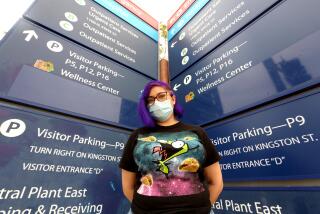Intensive Care Helps Hospitals Merge Smoothly
- Share via
When staff physicians first learned of an impending merger between the financially troubled Hollywood Presbyterian Medical Center and the aging Queen of Angels Medical Center, they wondered what the new facility would be called. History was at play, along with bureaucratic egos and marketing considerations.
“Some people said . . . it would be called Hollywood Angels,” recalled Dr. Samy Farag, medical chief of staff last year at Hollywood Presbyterian. Others, more accurately, predicted the new name inevitably would be a mouthful.
As it turned out, the decision to settle on “Queen of Angels-Hollywood Presbyterian Medical Center” was one of the easier steps in a complicated melding of two of the city’s oldest hospitals, which became official at a colorful ceremony Tuesday afternoon.
Rooted in economics, the merger presented administrators, physicians, nurses and custodians with a long list of intriguing logistical challenges. The task involved everything from billing to bedpans, surgeons to signage.
“It’s been fascinating, exciting, challenging and difficult,” Richard F. Smith, chief administrator of the hospital, said before the ceremony. “The only problem will be if we merge with any more hospitals. Then we’d have to take down the Hollywood sign in the Hollywood Hills to fit our name in one place.”
It all began last November when officials of Hollywood Presbyterian and nearby Queen of Angels, owned by the Franciscan Sisters of the Sacred Heart, announced the merger. To many health care professionals, it seemed a marriage made in heaven for two hospitals suffering from occupancy rates of less than 50%. The Catholic order, whose facility is 60 years old, could supply some needed cash to the financially strapped Hollywood Presbyterian. In return, it would merge its staff into the 10-story, 3-year-old Hollywood Presbyterian Tower.
Some wrinkles, including the question of which religion would prevail, were dealt with in the initial pact. The merged hospital, it was decided, would operate under Catholic rather than Presbyterian policies--with no abortions, tubal ligations or vasectomies allowed.
“There was the matter of the ‘R’ word--religion,” said hospital board Chairman J.J. Brandlin Tuesday. “Religion was an important aspect of the merger, (but) it took only about 15 minutes to solve all the issues.”
There also was the question of top billing. “We were having to close our hospital . . . and we provided some financing,” explained Brandlin, who formerly served as vice chairman of the Queen of Angels board. “It’s a very long name, but it was the easiest compromise.”
When it came time to address more pragmatic matters, hospital officials appointed a 30-member team headed by quality assurance director Dawn Vonderheide.
Faced with a six-week deadline, Vonderheide’s team drafted plans for transferring all patients out of Queen of Angels. The team also picked and chose among the hospital’s equipment and supplies, deciding which would be taken along and which would be discarded.
Virtually all supplies were trucked over to Hollywood Presbyterian, which had been running short. Wheelchairs, IV pumps, hospital beds, even bedpans, were transferred.
“It was all the way down to Band-Aids,” Vonderheide said.
Hospital officials, who arranged a $21-million state-guaranteed loan to support the merger, prepared a layoff list for those in redundant jobs. Eventually 150 employees from Queen of Angels and 300 more from Hollywood Presbyterian--ranging from orderlies to Hollywood Presbyterian Chief Executive Allene Nungesser--were let go.
Physicians, meanwhile, established a credentialing process with assistance from state health officials, guaranteeing hospital privileges for the 1,000 medical staffers of the two facilities.
Four days before the 404-bed Queen of Angels facility was permanently boarded up on Jan. 27, its emergency room and admissions ward were shut down. Over the course of that week, 60 Queen of Angels patients, many in critical condition, were rushed by ambulance two miles to the merged quarters at Vermont Avenue and Sunset Boulevard.
“Some nurses started their shifts in the Queen of Angels critical care unit and ended up their shifts at Hollywood Presbyterian when we brought their patients here,” Vonderheide said. “We couldn’t just throw them in an ambulance (without their nurses).”
Patients weathered the uprooting in good shape, officials said.
Relations between the two staffs were rocky at first in some departments, employees said. Nurses from the old facility had to learn how to operate computers at the new one. They also had to be retrained on such procedures as chart-keeping.
“It’s difficult at first to get used to,” said George Dean, an occupational therapist. “It’s like going to another culture, a kind of medical culture shock.”
The move is still not finished, with new Catscan and mammography machines waiting to be moved from Queen of Angels.
Also, no decision has been made on a new logo, so signs in the hospital and at the top of the 10-floor hospital tower still make no mention of Queen of Angels. Nor did the 1,000 balloons marked Hollywood Presbyterian that were released Tuesday at the conclusion of festivities.
More to Read
Sign up for Essential California
The most important California stories and recommendations in your inbox every morning.
You may occasionally receive promotional content from the Los Angeles Times.













